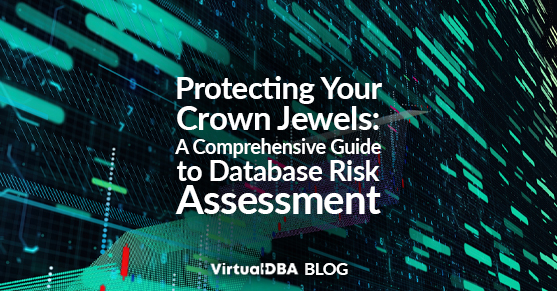Data is often considered an organization’s most valuable asset in today’s digital age. As such, the systems that house and manage this data – database management systems (DBMS) – require meticulous attention and protection. This blog post will delve into the critical aspects of corporate risk assessments for DBMS, providing a comprehensive checklist for organizations to safeguard their data, regardless of the vendor platform or whether the system is self-managed or cloud-based.
Understanding the Risks
Before diving into the checklist, you must grasp the potential threats to your DBMS. These can be categorized as follows:
- Data Loss: Accidental deletion, hardware failure, or ransomware attacks can lead to irreparable data loss.
- Data Breach: Unauthorized access to sensitive information can result in financial loss, reputational damage, and legal consequences.
- System Downtime: Failures or performance issues can disrupt business operations, leading to financial losses and customer dissatisfaction.
- Compliance Violations: Non-compliance with industry regulations can result in hefty fines and legal repercussions.
Comprehensive Risk Assessment Checklist
A robust risk assessment should encompass a wide range of factors. Here’s a detailed checklist:
General Risk Factors
- Data Classification: Understand the sensitivity of data stored in the DBMS. Classify data based on criticality to business operations.
- Business Impact Analysis: Assess the potential impact of data loss or system downtime on business operations.
- Threat Identification: Identify potential threats to the DBMS, including internal and external sources.
- Vulnerability Assessment: Evaluate the system’s weaknesses and potential entry points for attackers.
- Risk Assessment Methodology: Choose a suitable risk assessment methodology (e.g., FMEA, OCTAVE) to quantify and prioritize risks.
Self-Managed DBMS Specific Risks
- Physical Security: Assess the physical security of the data center, including access controls, environmental controls, and disaster recovery plans.
- Network Security: Evaluate the network infrastructure, including firewalls, intrusion detection systems, and network segmentation.
- System Configuration: Review system settings, default accounts, and permissions to identify potential vulnerabilities.
- Patch Management: Ensure timely application of patches and updates to address known vulnerabilities.
- Backup and Recovery: Verify the effectiveness of backup procedures and disaster recovery plans.
- Personnel Security: Implement background checks, access controls, and security awareness training for database administrators.
Cloud-Managed DBMS-Specific Risks
- Cloud Provider Security: Evaluate the provider’s security controls and certifications (e.g., SOC 2, ISO 27001).
- Data Residency and Sovereignty: Understand data location and compliance with relevant regulations.
- Access Controls: Review cloud-based access controls and identity management practices.
- Data Encryption: Verify data encryption at rest and in transit.
- Incident Response: Collaborate with the cloud provider to develop an incident response plan.
Data Security and Privacy
- Data Masking and Tokenization: Consider using these techniques to protect sensitive data.
- Data Loss Prevention (DLP): Discuss DLP policies and technologies to prevent accidental or malicious data exfiltration.
- Privacy Impact Assessments (PIAs): Highlight the importance of PIAs for understanding privacy risks.
Application Security
- Secure Coding Practices: Emphasize the role of secure coding in preventing vulnerabilities.
- Input Validation and Sanitization: Discuss the importance of protecting against injection attacks.
- Web Application Firewalls (WAF): Mention WAFs as a defense against web-based attacks.
Operational Resilience
- Business Continuity Planning (BCP): Elaborate on the creation of BCPs for database systems.
- Disaster Recovery Testing: Highlight the importance of regular testing of DR plans.
- Supply Chain Risk Management: Address the risks posed by third-party vendors and suppliers.
Emerging Threats
- Insider Threats: Discuss the potential risks from employees and contractors.
- Cloud Security Alliance (CSA) Controls: Mention the CSA as a valuable resource for cloud security standards.
- Zero-Trust Architecture: Explore the applicability of zero-trust principles to database environments.
Additional Considerations
- Cost-Benefit Analysis: Discuss the importance of balancing security measures with costs.
- Risk Tolerance: Address the concept of risk tolerance and how it influences risk management decisions.
- Continuous Monitoring and Improvement: Emphasize the ongoing nature of risk assessment and management.
- Regulatory Compliance: Ensure compliance with industry-specific regulations (e.g., HIPAA, GDPR, PCI DSS).
- Third-Party Risk Management: Assess risks associated with third-party vendors and service providers.
Conclusion
A comprehensive risk assessment is essential for protecting your organization’s valuable data. By carefully considering the factors outlined in this checklist, you can identify potential vulnerabilities, prioritize risks, and implement effective mitigation strategies. Remember, the nature of the risks will vary depending on whether your DBMS is self-managed or cloud-based. A tailored approach is crucial for achieving optimal security.
Partner with XTIVIA for Comprehensive Database Risk Management
Protecting your organization’s crown jewels – your data – requires a multi-faceted approach. A comprehensive risk assessment is the cornerstone of adequate database security. Organizations can implement targeted mitigation strategies to safeguard their valuable assets by identifying and prioritizing potential threats.
XTIVIA’s Virtual-DBA service offers a holistic solution to database risk management. Our team of experienced professionals provides expert guidance and support across the entire spectrum of database security, from risk assessment and vulnerability management to incident response and compliance.
With XTIVIA as your partner, you can:
- Reduce the risk of data breaches and downtime: Our experts identify and mitigate potential threats to your database environment.
- Enhance operational efficiency: Our virtual DBAs optimize database performance and availability.
- Ensure regulatory compliance: We help you meet industry-specific compliance requirements.
- Access specialized expertise: Benefit from our deep knowledge of database technologies and security best practices.
By partnering with XTIVIA, you gain access to a dedicated team of experts committed to protecting your organization’s most critical asset – your data.
Contact us today to learn more about how XTIVIA can help you safeguard your database environment.

